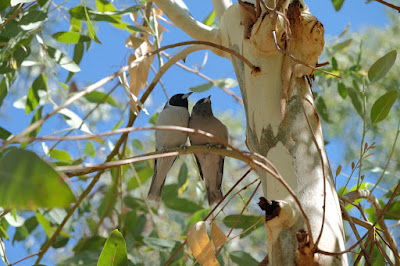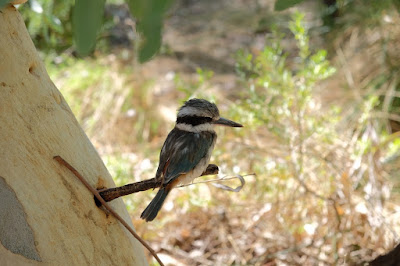One of the first sights that we visited was the Alice Springs School of the Air. We had learned about the origins of the School of the Air in Port Augusta, so it was interesting to see the modern-day center of this incredible education program. School of the Air is billed as "the largest classroom in the world" because its reach is 1.3 million square kilometers (521,000 square miles). That's double the size of Texas and 3 1/2 times the size of Germany!
Started in 1951, School of the Air was an improvement to the correspondence courses that children in the Outback had been using. School of the Air used radio-transmitted lessons to provide community and socialization opportunities to children who may not have regularly come into contact with other children or people outside their own family.
At first, School of the Air used radios to transmit lessons over the air to children--the first radios were even pedal powered! Today, the School of the Air utilizes online technology and satellite internet to more easily educate and connect children who live in remote parts of Australia. Unfortunately, no live lessons were taking place due to the Easter holiday period, but we were able to see the studios that teachers use to provide lessons.
We saw some of the antiquated equipment that was replaced by computers and satellite internet.
And we saw different projects that were completed by students of School of the Air. In addition to online courses, the students have the opportunity to come together 4 times a year in Alice Springs for in-person events. These optional weeks provide an additional chance for the students to have the experience of learning, playing, and interactin with other children. School of the Air is such a unique way of educating children, and it was really impressive to see how technology and creativity can make a big difference in the lives and education of Australian Outback children.
Another day we visited the Alice Springs Desert Park, which houses animals and plants that are native to the central Australian desert. We saw a lot of beautiful desert birds.
One of the highlights for us were the Thorny Devils, including baby Thorny Devils!
Thorny Devils are amazing creatures. They have a false head on the back of their neck to trick predators into attacking that instead of the actual head. Their scales are also ridged so that when it rains the water runs from the scales into their mouth.
This little guy is a skink.
Can you find the lizard in this photo?
We saw a lot of snakes, including the Death Adder. The Death Adder will lie under a rock, camouflaged, and stay super still. However, its black tail pokes out and moves from side to side, which will attract curious mice and rats into striking distance. Then the Death Adder strikes, using venom to kill its prey.
We listened to one of the Aboriginal guides talk about food sources in the Outback. These are bush coconuts, also known as bloodwood apples, that are often eaten by Aboriginal people in central Australia.
We watched a free-flying bird show, in which large birds of prey demonstrated their incredible flying, tracking, and diving skills.
We saw Red Kangaroos, who were really skittish as we walked through their enclosure.
We listened to the guide also talk all about emus, including how the male emu sits on the eggs until they hatch and then cares for the chicks.
There was definitely a bit of a Wild West feeling to Alice Springs, due in part to buildings like this one.
We climbed ANZAC Hill, which had a panoramic observation point over Alice Springs and the West MacDonnell Range.
At the top we saw the memorial to all the service members who have fought over the years for Australia.
We also saw this very unique cat, which was being walked on a leash by its owner. We chatted for a bit, and she told us that this is a Bengal cat whose ancestry is part leopard.
We also visited the Alice Springs Reptile Centre, which houses interesting animals from all over Australia. All 3 boys wanted to see the wide range of venomous snakes housed at the centre and, specifically, a Taipan.
Here's the winner of the "Most Venomous Snake" contest--the Inland Taipan!
This is an Eastern Brown Snake, #2 on the "Most Venomous" list above.
There was another Death Adder, this one of the Northern variety.
There was also a Pig-Nosed Turtle, who was so funny looking!
And a baby Saltwater Crocodile.
And more Thorny Devils! Thorny Devils eat ants exclusively, and we watched one of the adults vacuuming up ants who were running past in a line. It was really cool to watch him eating the ants methodically one after another.
We attended a Reptile Talk that focused on first aid for snake bites and on a couple of the centre's resident animals.
The boys were thrilled to get to hold this massive python.
Crocodiles can be a real threat to humans in parts of Australia. They are highly territorial and will attack most anything that comes in their space. We were warned over and over to stay well away from bodies of water in the northern parts of Australia.
The owner was confident enough in Terry to take a cell phone call while he was in the enclosure. Yikes!
On Easter, our stay in Alice Springs ended. We said goodbye to the beautiful Red Center of Australia and to Alice Springs and hopped on a plane. Next stop: tropical north Queensland!






























































No comments:
Post a Comment